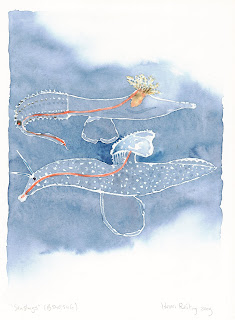In the previous entries I focussed on Ernst Haeckel. This entry focuses on plate 77 in his Kunstformen der Natur (Art Forms in Nature), published in 1899 -1904, in order to stimulate the decorative arts.
 |
| Praya cymbiformis (B 215), 2009 (60x50 cm) |
The image shows a recently made watercolour (2009), and it is an interpretation of Praya cymbiformis, a colony building jellyfish. The Blaschkas made a glass model of this species, with catalogue number 215.
This watercolour of Praya cymbiformis has a pedigree going back to 1854.
In that year, the German zoologist Carl Gegenbaur describes this species in his illustrated publication: "Beiträge zur näheren Kenntniss der Schwimmpolypen (Siphonophoren)", in: Zeitschrift für wissenschaftliche Zoologie, Bd. 5. Leipzig: Engelmann, 1854, pp. 285-344.
It is known that the Blaschkas have based circa ten models on illustrations from publications by Gegenbaur.
Gegenbaur's scientific illustrations are copied by the Blaschkas, and these copies have been stored among their documentation, to be used as preparatory drawings for the production of glass models. A few of the models of this specific species survive until today and photographic material of one of these is provided by the Natural History Museum in Geneva. In turn, this is put to use as the preparatory image for the watercolour.
So, the image went from two dimensions in the original printed publication to three dimensions in the model and then back again to the two dimensions of the photo and painting. The process of copying reminds also of 16th century science, a period when science is highly document based. Further, it is important to understand that the image does not show an animal, but the species, a concept which is in itself an abstraction.
At every stage, the used imaging technique alters characteristics of the representation. The glass workers Blaschka specifically have added stiffness: undulating lines may have been straightened and stylised. By using watercolour, I re-introduced a wet look and feel.
The animal indicated as Praya galea on plate 77 (Siphonophorae. Staatsquallen) in Kunstformen der Natur / Art Forms in Nature by Ernst Haeckel (1834-1919) looks quite similar, and it is based on Haeckel's work on the siphonophores of the Challenger expedition. (E.
Haeckel, ‘Report on the Siphonophorae collected by H.M.S. Challenger during the
years 1873-1876’ Report on the Scientific
results of the voyage of H.M.S. Challenger during the years 1873 – 76 [ …], Zoology
28 Pt. 27 - 1888) .
Haeckel
applies elaborate undulation to the stem of the colony and to the
tentacles, thus adding extra decorative features to the image. This is
interesting, because Haeckel intends to influence specifically the
decorative arts by the wealth of forms found in nature. Reiling takes
this idea one step further, by exploring the representations of
invertebrates and reinterpreting these as art forms in their own right.





